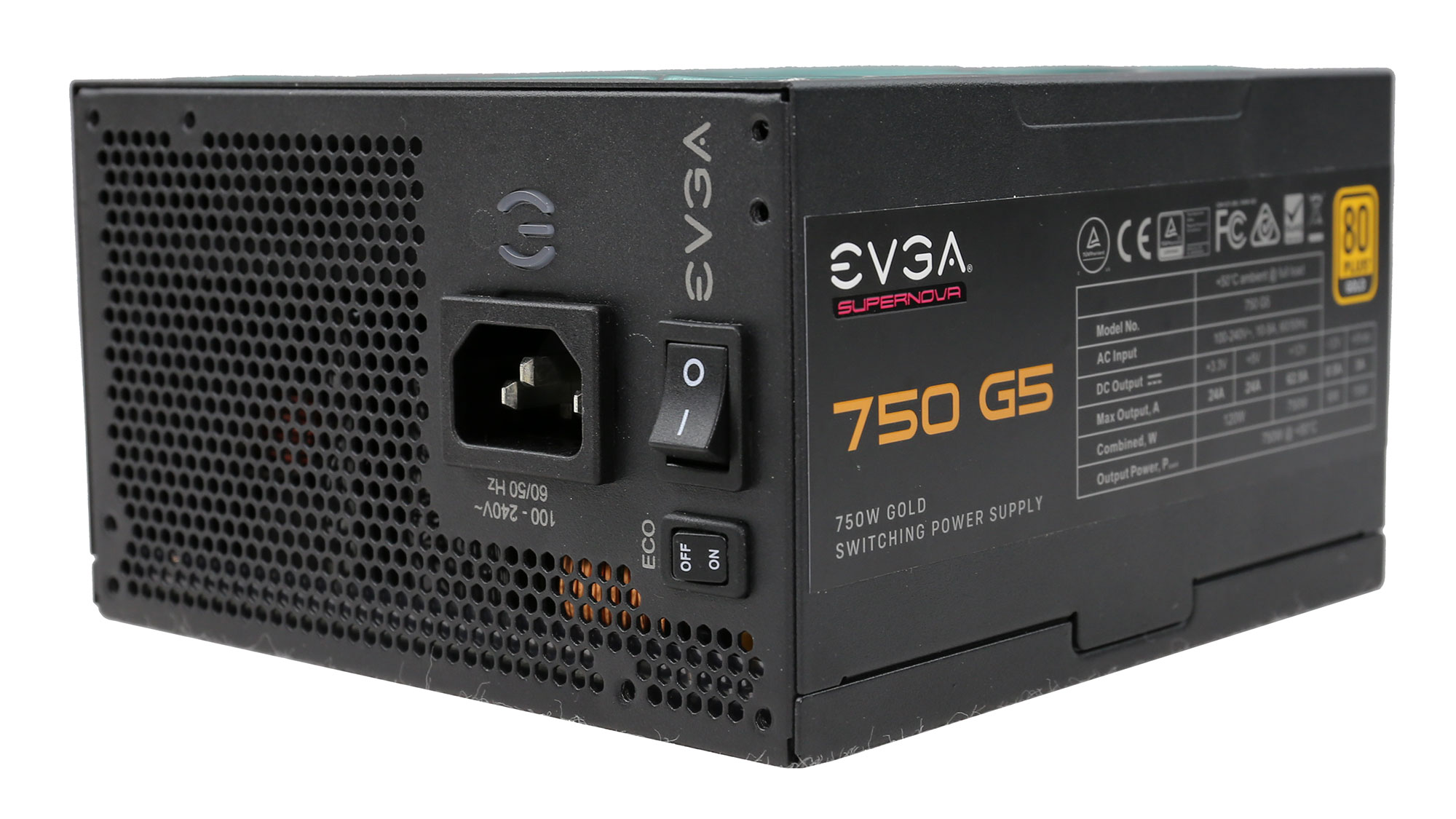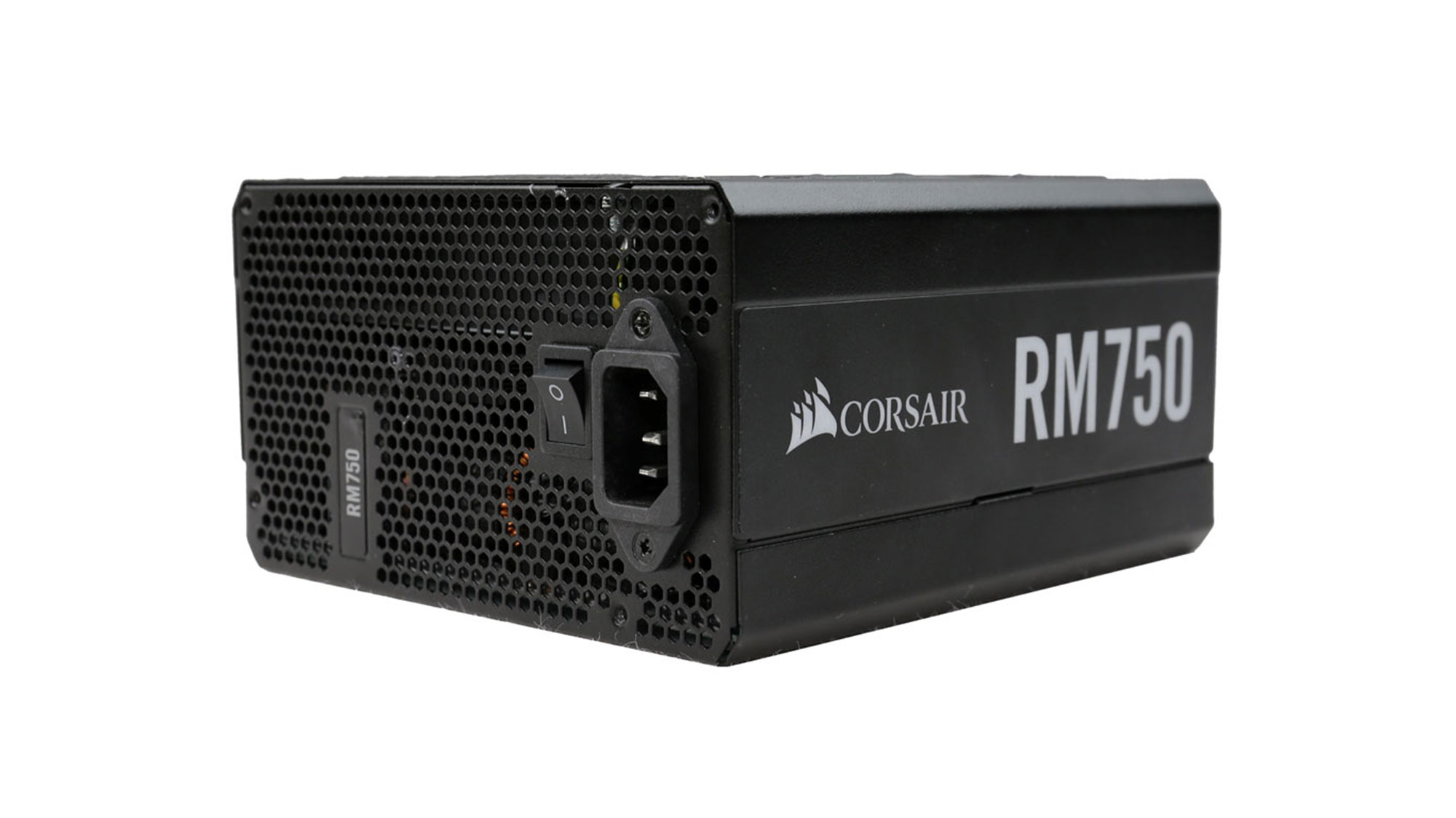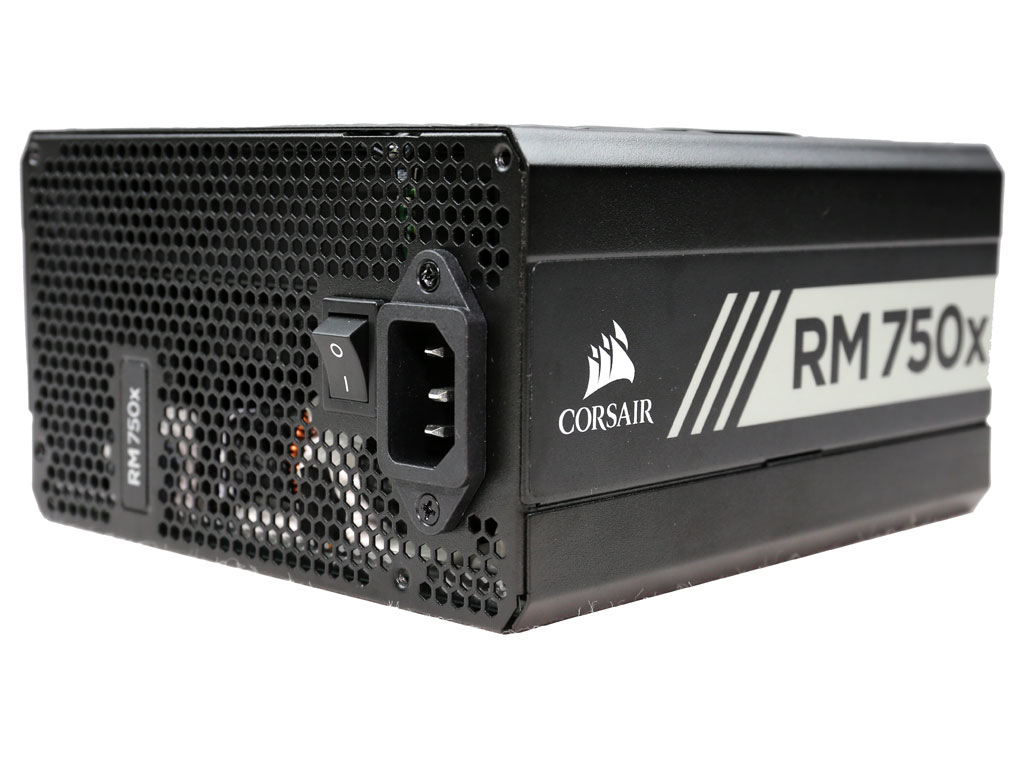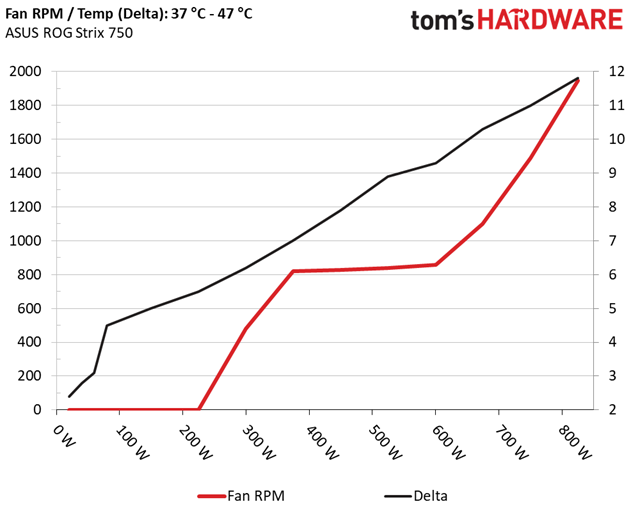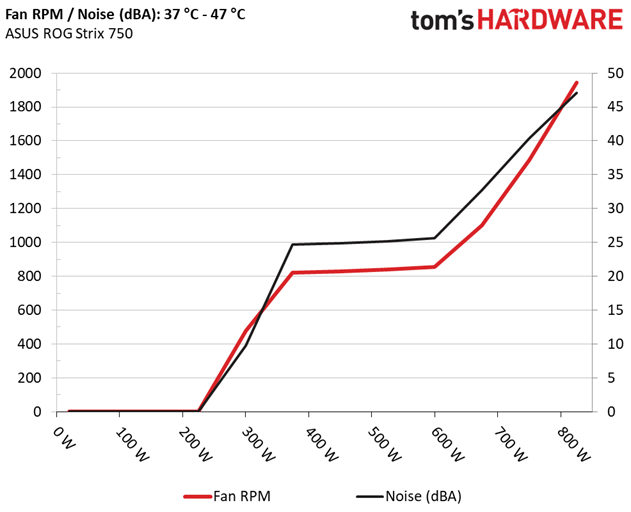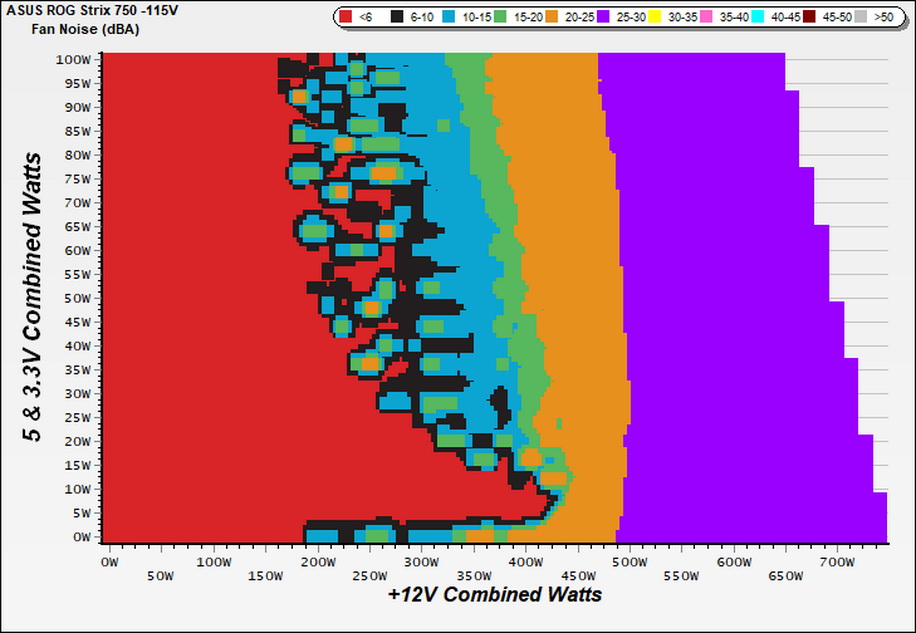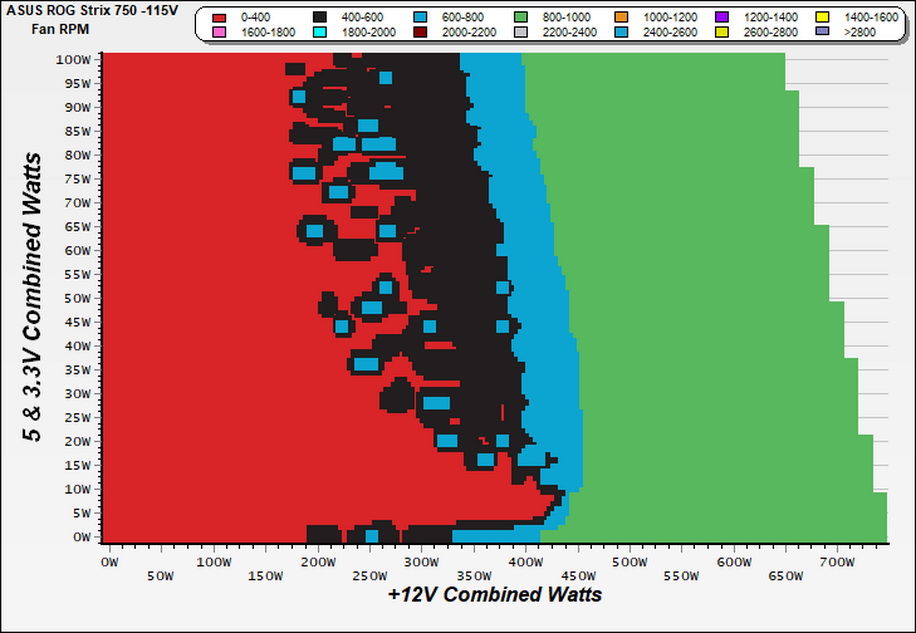Why you can trust Tom's Hardware
To learn more about our PSU tests and methodology, please check out How We Test Power Supply Units.
Primary Rails And 5VSB Load Regulation
The following charts show the main rails' voltage values recorded between a range of 40W up to the PSU's maximum specified load, along with the deviation (in percent). Tight regulation is an important consideration every time we review a power supply because it facilitates constant voltage levels despite varying loads. Tight load regulation also, among other factors, improves the system’s stability, especially under overclocked conditions and, at the same time, it applies less stress to the DC-DC converters that many system components utilize.
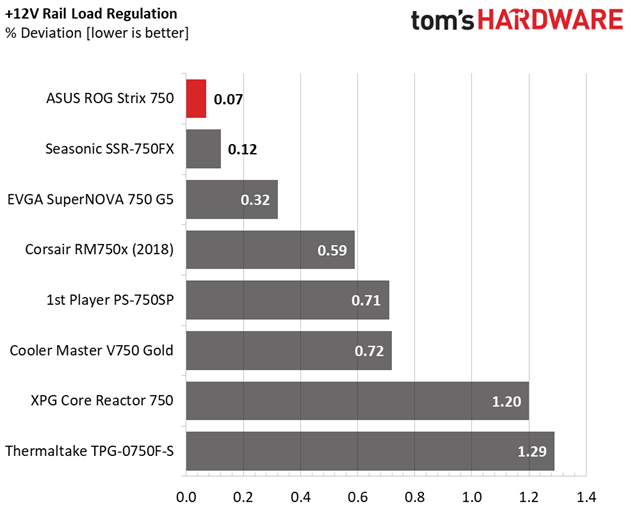
Results 1-8: Load Regulation
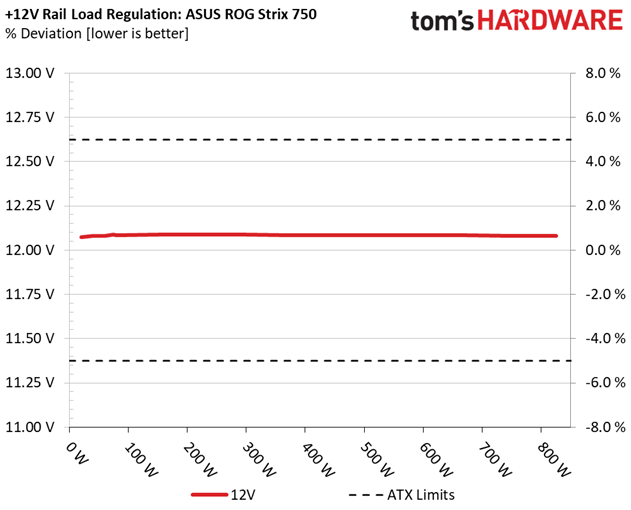
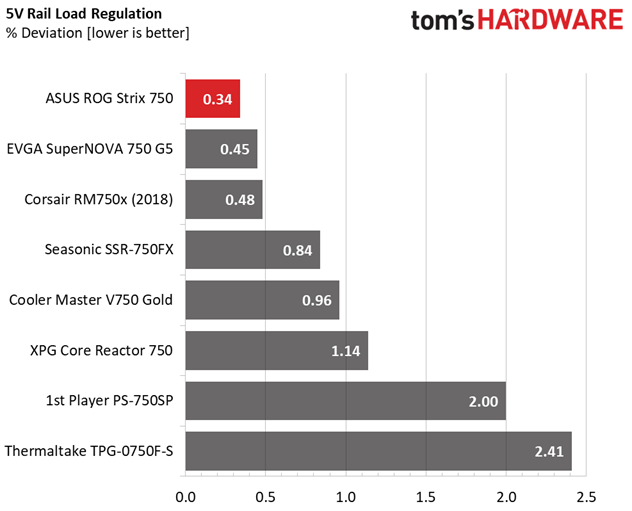
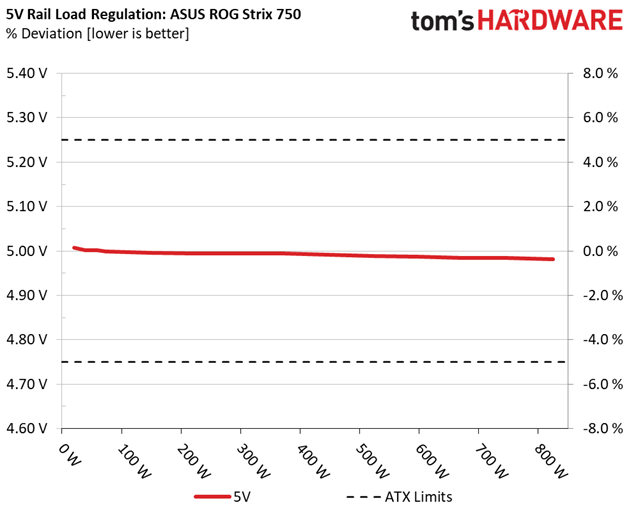
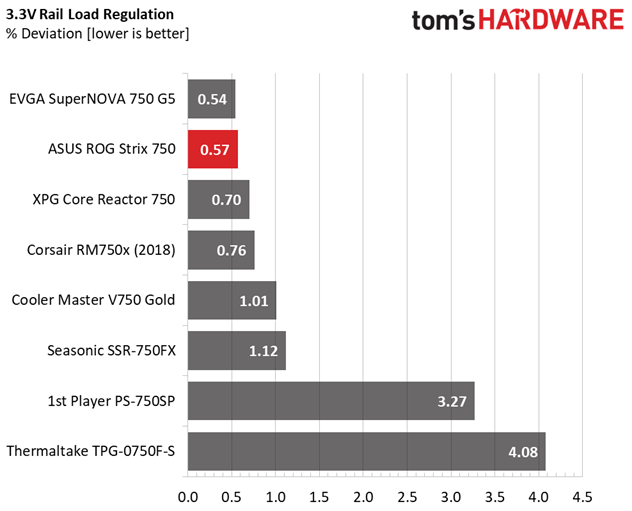
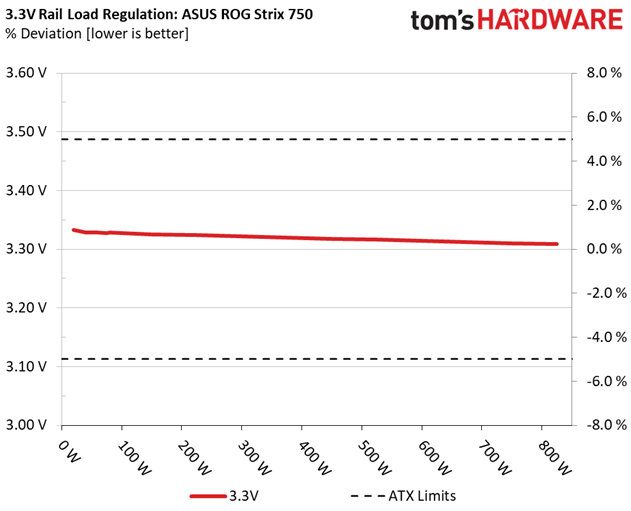
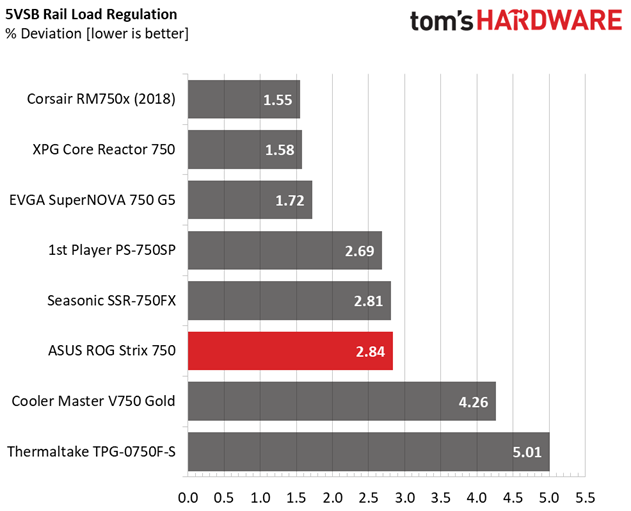
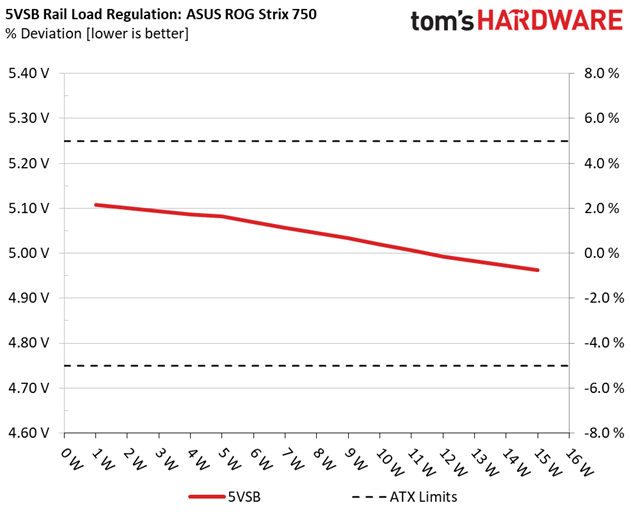
The load regulation is extra tight on all rails but 5VSB, where it is just satisfactory.
Hold-Up Time
Put simply; hold-up time is the amount of time that the system can continue to run without shutting down or rebooting during a power interruption.
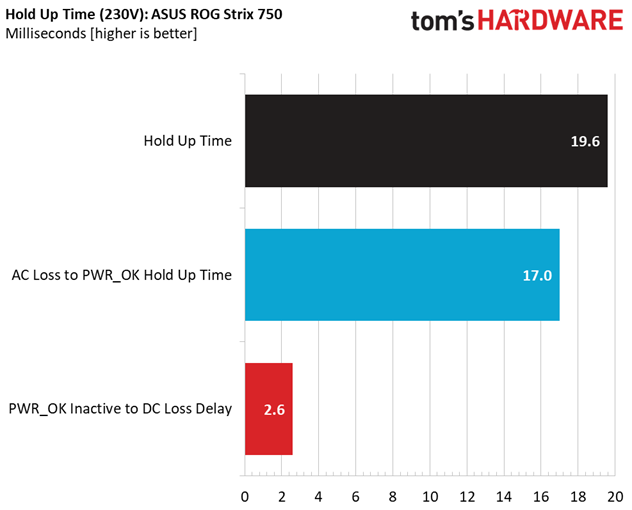
Results 9-12: Hold-Up Time
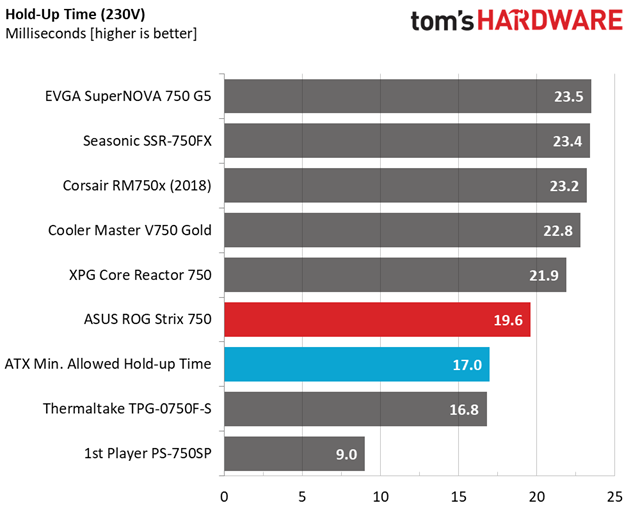
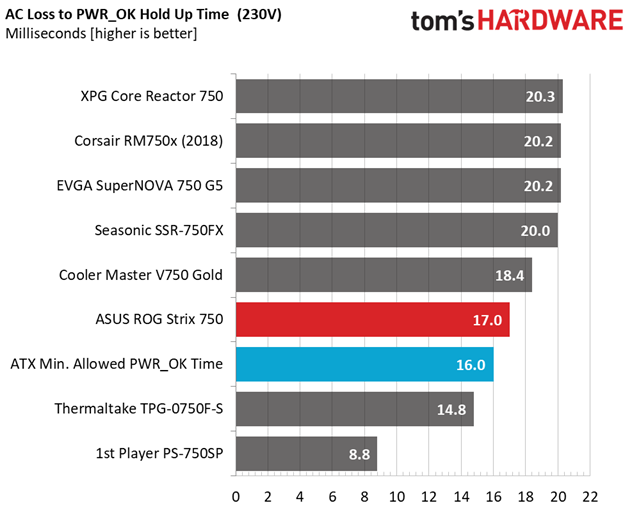
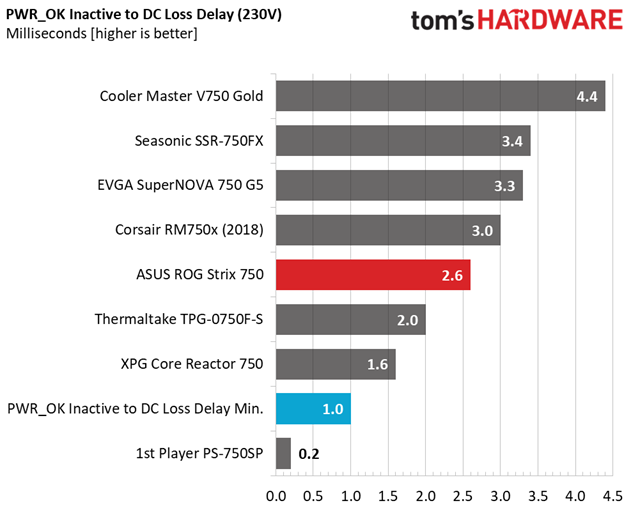
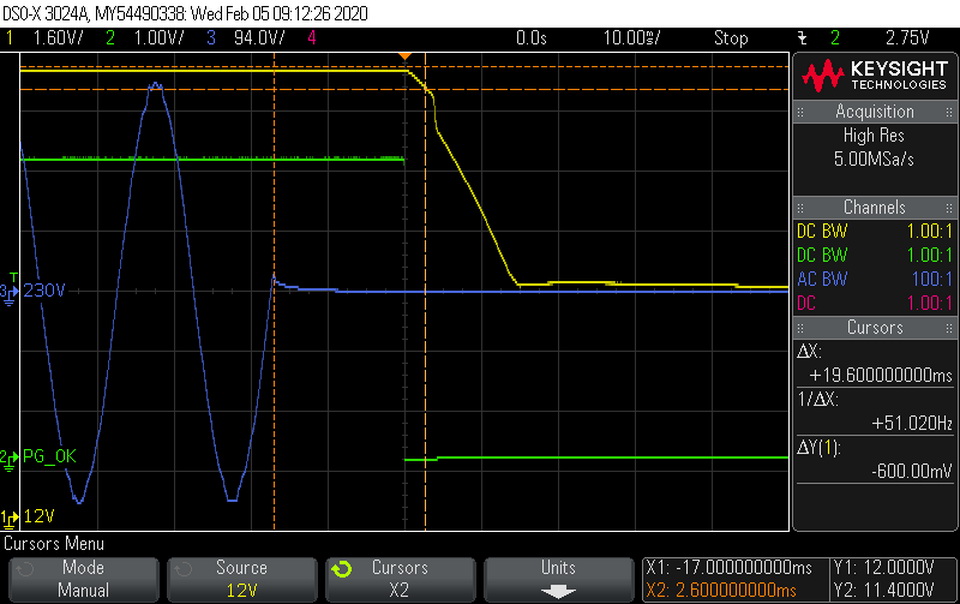
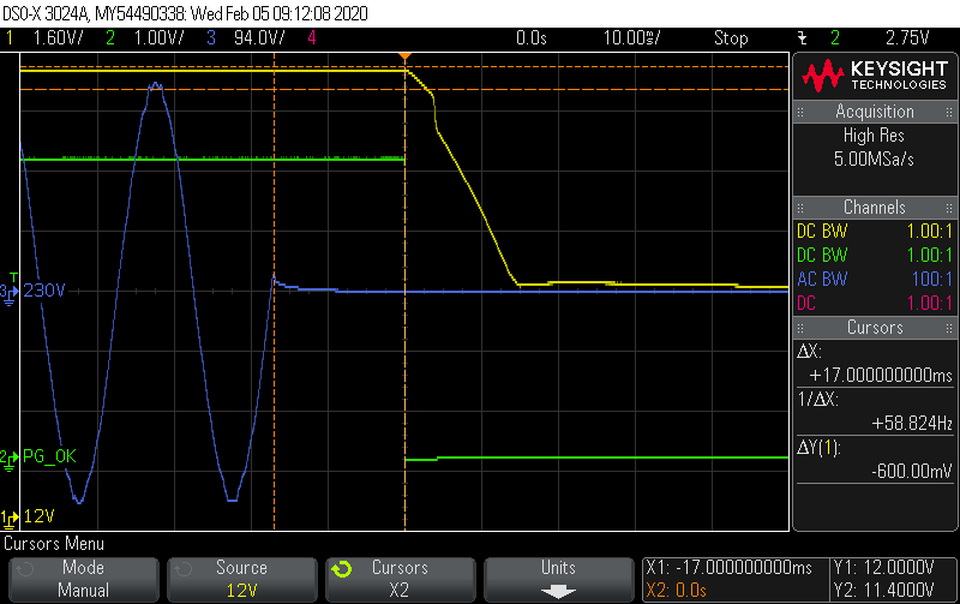

The hold-up time is close to 20ms and the power-ok signal is accurate.
Inrush Current
Inrush current, or switch-on surge, refers to the maximum, instantaneous input current drawn by an electrical device when it is first turned on. A large enough inrush current can cause circuit breakers and fuses to trip. It can also damage switches, relays, and bridge rectifiers. As a result, the lower the inrush current of a PSU right as it is turned on, the better.
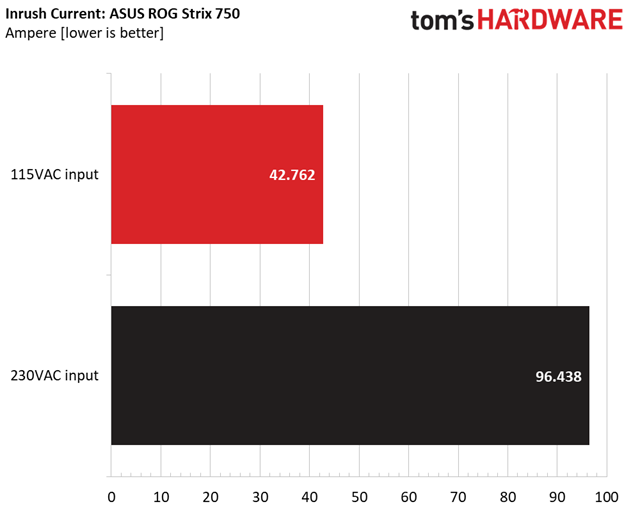
Results 13-14: Inrush Current
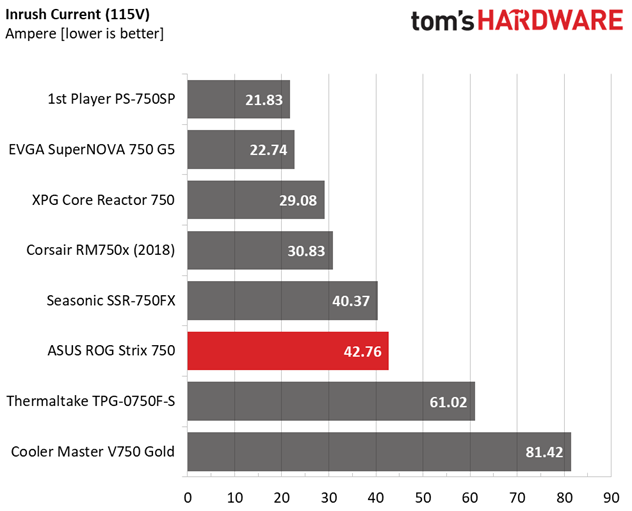
The inrush current is quite high with 230V, and at normal levels with 115V input.
Get Tom's Hardware's best news and in-depth reviews, straight to your inbox.
10-110% Load Tests
These tests reveal the PSU's load regulation and efficiency levels under high ambient temperatures. They also show how the fan speed profile behaves under increased operating temperatures.
| Test # | 12V | 5V | 3.3V | 5VSB | DC/AC (Watts) | Efficiency | Fan Speed (RPM) | PSU Noise (dB[A]) | Temps (In/Out) | PF/AC Volts |
| 1 | 4.414A | 1.999A | 1.986A | 0.984A | 74.953 | 85.554% | 0 | <6.0 | 44.89°C | 0.925 |
| 12.087V | 4.999V | 3.327V | 5.082V | 87.609 | 40.38°C | 115.09V | ||||
| 2 | 9.855A | 3.000A | 2.977A | 1.184A | 150.006 | 89.178% | 0 | <6.0 | 45.67°C | 0.954 |
| 12.087V | 4.996V | 3.325V | 5.069V | 168.210 | 40.68°C | 115.09V | ||||
| 3 | 15.632A | 3.504A | 3.475A | 1.384A | 225.008 | 90.311% | 0 | <6.0 | 46.28°C | 0.969 |
| 12.088V | 4.994V | 3.324V | 5.057V | 249.149 | 40.76°C | 115.09V | ||||
| 4 | 21.413A | 4.004A | 3.972A | 1.586A | 300.016 | 90.252% | 478 | 9.8 | 41.19°C | 0.977 |
| 12.087V | 4.995V | 3.322V | 5.045V | 332.421 | 47.35°C | 115.09V | ||||
| 5 | 26.810A | 5.007A | 4.971A | 1.788A | 374.482 | 90.004% | 820 | 24.7 | 42.18°C | 0.981 |
| 12.084V | 4.994V | 3.320V | 5.034V | 416.071 | 49.13°C | 115.09V | ||||
| 6 | 32.245A | 6.011A | 5.967A | 1.992A | 449.422 | 89.591% | 829 | 24.9 | 42.49°C | 0.983 |
| 12.083V | 4.992V | 3.318V | 5.020V | 501.640 | 50.36°C | 115.09V | ||||
| 7 | 37.708A | 7.017A | 6.968A | 2.197A | 524.740 | 89.120% | 840 | 25.2 | 43.20°C | 0.986 |
| 12.083V | 4.989V | 3.316V | 5.007V | 588.799 | 52.07°C | 115.09V | ||||
| 8 | 43.167A | 8.003A | 7.965A | 2.404A | 599.940 | 88.555% | 857 | 25.6 | 44.05°C | 0.987 |
| 12.084V | 4.987V | 3.314V | 4.993V | 677.475 | 53.35°C | 115.09V | ||||
| 9 | 48.996A | 8.526A | 8.454A | 2.408A | 674.575 | 87.881% | 1100 | 32.7 | 44.37°C | 0.989 |
| 12.084V | 4.985V | 3.312V | 4.986V | 767.603 | 54.62°C | 115.09V | ||||
| 10 | 54.639A | 9.030A | 8.970A | 3.023A | 749.793 | 87.071% | 1487 | 40.4 | 45.55°C | 0.990 |
| 12.081V | 4.984V | 3.310V | 4.963V | 861.130 | 56.59°C | 115.08V | ||||
| 11 | 60.876A | 9.032A | 8.976A | 3.027A | 825.022 | 86.257% | 1945 | 47.1 | 46.84°C | 0.990 |
| 12.079V | 4.982V | 3.309V | 4.956V | 956.474 | 58.64°C | 115.08V | ||||
| CL1 | 0.102A | 12.000A | 11.998A | 0.000A | 100.900 | 84.017% | 605 | 16.1 | 42.54°C | 0.943 |
| 12.100V | 4.987V | 3.319V | 5.086V | 120.095 | 50.10°C | 115.11V | ||||
| CL2 | 62.010A | 1.000A | 1.000A | 1.000A | 762.286 | 87.484% | 1553 | 41.3 | 45.01°C | 0.990 |
| 12.078V | 4.993V | 3.317V | 5.020V | 871.341 | 55.78°C | 115.09V |
The power supply has high tolerance in increased operating temperatures, and the efficiency levels are satisfactory. Even at such high temperatures, the PSU meets the 80 PLUS Gold requirements.
20-80W Load Tests
In the following tests, we measure the PSU's efficiency at loads significantly lower than 10% of its maximum capacity (the lowest load the 80 PLUS standard measures). This is important for representing when a PC is idle with power-saving features turned on.
| Test # | 12V | 5V | 3.3V | 5VSB | DC/AC (Watts) | Efficiency | Fan Speed (RPM) | PSU Noise (dB[A]) | PF/AC Volts |
| 1 | 1.229A | 0.499A | 0.493A | 0.196A | 19.982 | 69.437% | 0 | <6.0 | 0.840 |
| 12.074V | 5.008V | 3.333V | 5.108V | 28.777 | 115.08V | ||||
| 2 | 2.456A | 0.999A | 0.993A | 0.392A | 39.970 | 79.867% | 0 | <6.0 | 0.895 |
| 12.080V | 5.001V | 3.329V | 5.101V | 50.046 | 115.09V | ||||
| 3 | 3.688A | 1.499A | 1.487A | 0.589A | 60.002 | 84.053% | 0 | <6.0 | 0.918 |
| 12.081V | 5.001V | 3.329V | 5.094V | 71.386 | 115.09V | ||||
| 4 | 4.912A | 2.000A | 1.983A | 0.786A | 79.952 | 86.472% | 0 | <6.0 | 0.926 |
| 12.084V | 4.999V | 3.328V | 5.087V | 92.460 | 115.09V |
With 20% and 40% load, it would be nice to see higher than 70% and 80% efficiency levels, respectively.
2% or 10W Load Test
Intel plans on raising the ante at efficiency levels under ultra-light loads. So from July 2020, the ATX spec will require 70% and higher efficiency with 115V input. The applied load is only 10W for PSUs with 500W and lower capacities, while for stronger units, we dial 2% of their max-rated-capacity.
| Test # | 12V | 5V | 3.3V | 5VSB | DC/AC (Watts) | Efficiency | Fan Speed (RPM) | PSU Noise (dB[A]) | PF/AC Volts |
| 1 | 1.079A | 0.210A | 0.210A | 0.052A | 15.036 | 63.507% | 0 | <6.0 | 0.818 |
| 12.063V | 5.013V | 3.334V | 5.113V | 23.676 | 115.08V |
The unit cannot pass the 70% mark, with 2% of its max-rated-load and this means that it doesn't meet the corresponding ATX requirement which will be in effect
Efficiency
Next, we plotted a chart showing the PSU's efficiency at low loads, and loads from 10 to 110% of its maximum-rated capacity. The higher a PSU’s efficiency, the less energy goes wasted, leading to a reduced carbon footprint and lower electricity bills.
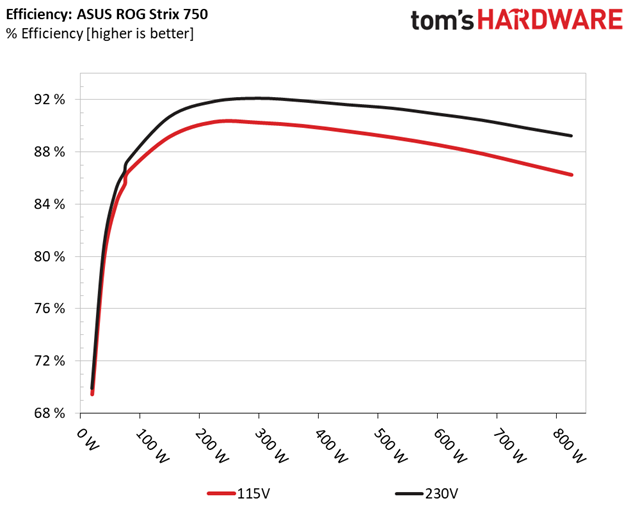
Results 15-18: Efficiency
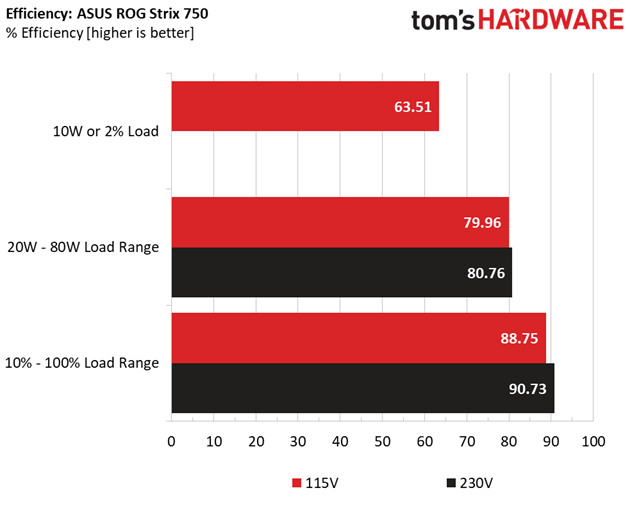
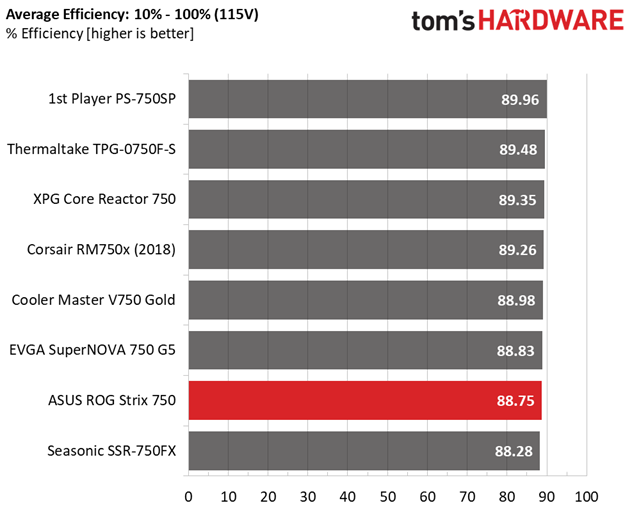
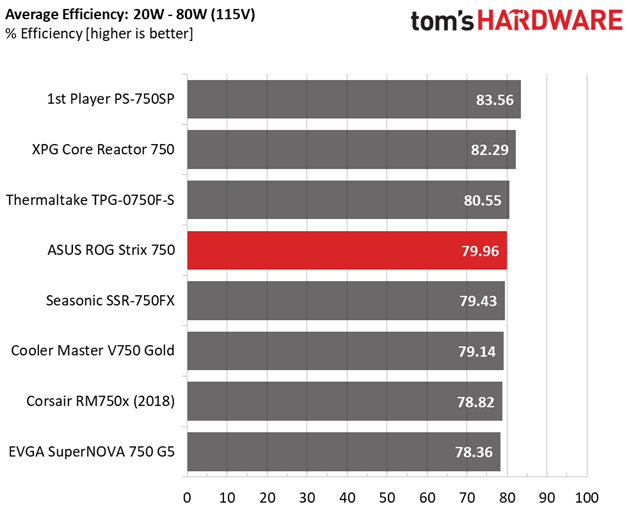
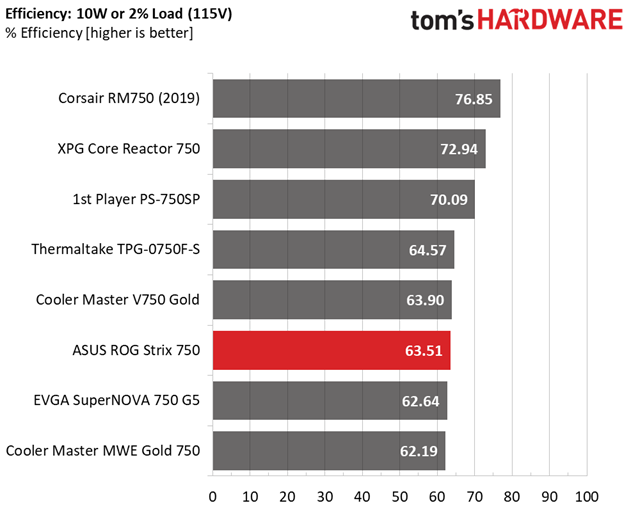
The overall efficiency at normal loads is satisfactory, although lower than what the majority of the competition achieves, while with light loads is high enough. The problem is with a 2% load, where the PSU cannot reach the 70% mark.
5VSB Efficiency
| Test # | 5VSB | DC/AC (Watts) | Efficiency | PF/AC Volts |
| 1 | 0.100A | 0.511 | 72.585% | 0.111 |
| 5.112V | 0.704 | 115.12V | ||
| 2 | 0.250A | 1.278 | 75.666% | 0.223 |
| 5.109V | 1.689 | 115.12V | ||
| 3 | 0.550A | 2.807 | 77.094% | 0.334 |
| 5.103V | 3.641 | 115.12V | ||
| 4 | 1.000A | 5.093 | 77.015% | 0.402 |
| 5.093V | 6.613 | 115.12V | ||
| 5 | 1.500A | 7.622 | 77.044% | 0.438 |
| 5.081V | 9.893 | 115.12V | ||
| 6 | 3.000A | 15.126 | 75.728% | 0.488 |
| 5.042V | 19.974 | 115.11V |
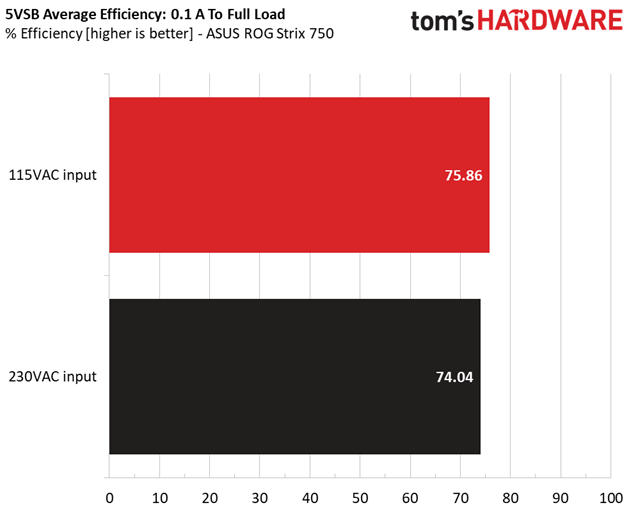
Results 19-20: 5VSB Efficiency
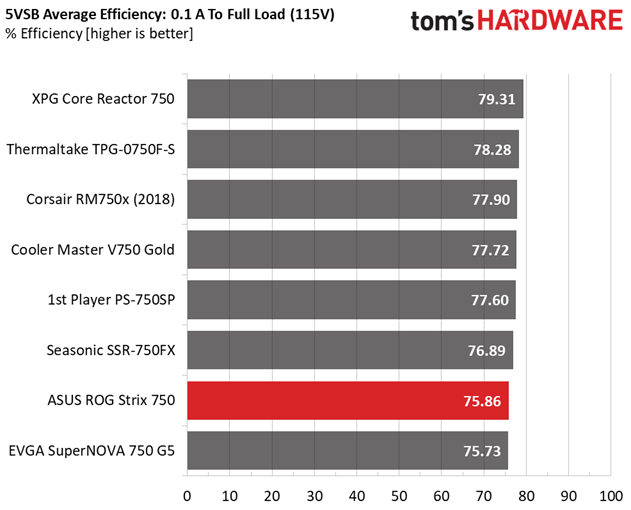
The 5VSB circuit needs an upgrade, for increased efficiency.
Power Consumption In Idle And Standby
| Mode | 12V | 5V | 3.3V | 5VSB | Watts | PF/AC Volts |
| Idle | 12.046V | 5.017V | 3.333V | 5.118V | 8.985 | 0.595 |
| 115.1V | ||||||
| Standby | 0.057 | 0.009 | ||||
| 115.1V |

Results 21-22: Vampire Power
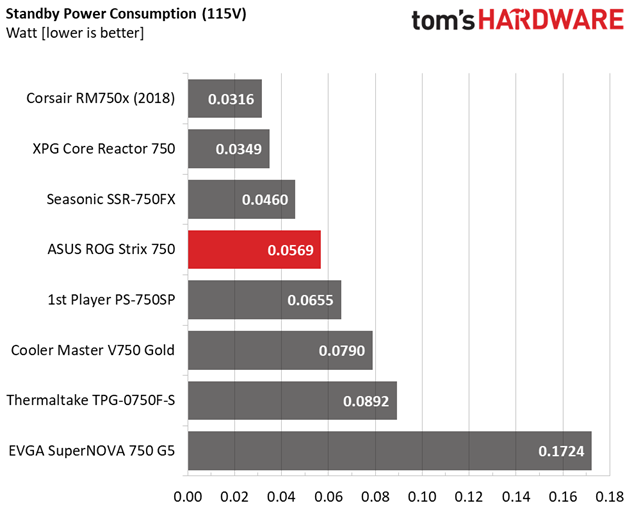
The PSU consumes low energy levels at standby.
Fan RPM, Delta Temperature, And Output Noise
All results are obtained between an ambient temperature of 37 to 47 degrees Celsius (98.6 to 116.6 degrees Fahrenheit).
The fan profile is highly relaxed, even at high operating temperatures that exceed 40 degrees Celsius.
The following results were obtained at 30 to 32 degrees Celsius (86 to 89.6 degrees Fahrenheit) ambient temperature.
The semi-passive operation doesn't last long, but the fan's speeds remain low in all cases, and so does the noise output.
MORE: Best Power Supplies
MORE: How We Test Power Supplies
MORE: All Power Supply Content
Current page: Load Regulation, Hold-Up Time, Inrush Current, Efficiency and Noise
Prev Page Specifications and Part Analysis Next Page Protection Features, DC Power Sequencing, Cross-Load Tests and Infrared Images
Aris Mpitziopoulos is a contributing editor at Tom's Hardware, covering PSUs.
-
octavecode I was about to say "looks a lot like a Seasonic unit" then i checked the manufacturer. :PReply
Best PSU reviewer , greetings from Greece.
Stay strong and healthy everybody. -
Aris_Mp Replyoctavecode said:I was about to say "looks a lot like a Seasonic unit" then i checked the manufacturer. :p
Best PSU reviewer , greetings from Greece.
Stay strong and healthy everybody.
Thank you for your kind words! -
karthyks Not sure if I got a faulty unit. I built a PC with Ryzen 3900x and Gigabyte Rtx 2080 Super along with this PSU. And it failed me after 3 days. My PC shuts down whenever I login to windows and randomly when I open a exe file. After swapping new motherboard, new Ram, new graphics card, i found the problem is with PSU. And I use thermaltake 850W 80+ and now everything is good so far.Reply -
SlavkoBilder Reply
its not because of the psu, the psu is good, but it doesnt have enough volts to power that cpu and graphics, its like a mouse is pushing a steel cube, just doesnt work out.karthyks said:Not sure if I got a faulty unit. I built a PC with Ryzen 3900x and Gigabyte Rtx 2080 Super along with this PSU. And it failed me after 3 days. My PC shuts down whenever I login to windows and randomly when I open a exe file. After swapping new motherboard, new Ram, new graphics card, i found the problem is with PSU. And I use thermaltake 850W 80+ and now everything is good so far. -
Schlachtwolf ReplySlavkoBilder said:its not because of the psu, the psu is good, but it doesnt have enough volts to power that cpu and graphics, its like a mouse is pushing a steel cube, just doesnt work out.
A 750w PSU is more than enough for a 3900x which itself will never really get over 150w, and an RTX 2080 super, but back to the theme I have the ROG Thor 850w and it is the best PSU I ever had in my 25 years having a PC. Asus is not cheap in any facet of hardware but the quality of their components is some of the best out there. -
PizzaChet Hi all! I just bought a bunch of ROG parts and got the THOR 850W PS. I've been seeing some similar builds out there and some say if you OC the CPU, it might get a little tight on wattage. Could you please share what you all think is a safe amount of overhead? I haven't decided on how far I want to go on overclocking yet. Here's the current list and estimated wattage...Reply
PC Parts Picker estimated the wattage of this build at 538W
MSI GeForce RTX 3070 Ventus 2X OC Gaming Graphics Card, 8GB GDDR6, PCIe 4.0, Ray Tracing, VR Ready, 3X DisplayPort 1.4, 1x HDMI 2.1 8K, DirectX 12 Ultimate, TORX Fan 3.0 w/ Mytrix HDMI CableIntel Core i9-10900X Desktop Processor 10 Cores up to 4.7GHz Unlocked LGA2066 X299 Series 165W (BX8069510900X)
SAMSUNG 970 EVO Plus SSD 2TB - M.2 NVMe Interface Internal Solid State Drive with V-NAND Technology (MZ-V7S2T0B/AM)
ASUS ROG Thor 850 Certified 850W Fully-Modular RGB Power Supply with LiveDash OLED Panel
Asus ROG Strix Helios GX601 RGB Mid-Tower Computer Case for up to EATX Motherboards with USB 3.1 Front Panel, Smoked Tempered Glass, Brushed Aluminum and Steel Construction, and Four Case Fans, Black
ASUS ROG Strix LC 360 RGB All-in-one AIO Liquid CPU Cooler 360mm Radiator, Intel 115x/2066 and AMD AM4/TR4 Support, Triple 120mm 4-pin PWM Fans (Addressable RGB Fans)
2x Corsair Vengeance RGB Pro 32GB (2x16GB) DDR4 3200 (PC4-25600) C16 Desktop Memory - Black (CMW32GX4M2C3200C16)
ASUS ROG Strix X299-E Gaming II ATX Gaming Motherboard (Intel X299) LGA 2066, Wi-Fi 6 (802.11ax), 2.5 GBS LAN, 8X DIMM Max. 256GB, USB 3.2 Gen 2, 8X SATA, 3X M.2, OLED and Aura Sync RGB -
Schlachtwolf I have that PSU too, you will be fine with 850w. Normally you allow for 20% overhead, you still have plenty of room.....Reply
